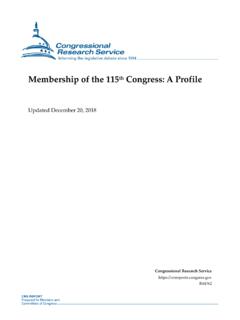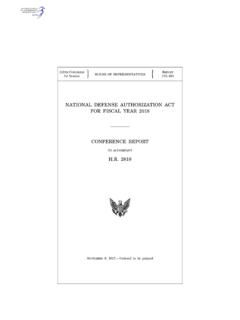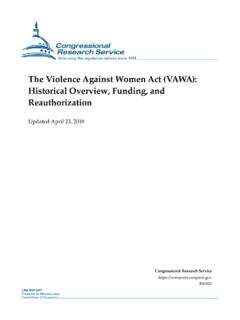Transcription of Report on Rare Earth Elements from Coal and Coal ... - Energy
1 Report on Rare Earth Elements from Coal and Coal Byproducts Report to congress January 2017 United States Department of Energy Washington, DC 20585 Message from the Secretary I am pleased to submit the enclosed Report , Rare Earth Elements from Coal and Coal Byproducts. This Report outlines the assessment and analysis of the feasibility of economically recovering rare Earth Elements from coal and coal byproduct streams such as fly ash, coal refuse, and aqueous effluents. This Report was prepared by the Department of Energy , Office of Fossil Energy (FE), National Energy Technology Laboratory (NETL) in response to an Explanatory Statement introduced in the House of Representatives in connection with the Consolidated Appropriations Act, 2014 (Public Law 113-76 (Jan.))
2 17, 2014).1 The assessment and analysis effort was led by FE/NETL and conducted in collaboration with industry, academia, and NETL s Office of Research and Development (ORD). In addition, the assessment and analysis was informed by industry, academia, and national laboratory responses to the DOE Request for Information (RFI) for DE-FOA-0001202. The results of this assessment and analysis have been made publicly available through This Report is being provided to the following Members of congress : The Honorable Joseph R. Biden, Jr. President of the Senate The Honorable Paul Ryan Speaker of the House of Representatives The Honorable Thad Cochran Chairman, Committee on Appropriations The Honorable Harold Rogers Chairman, Committee on Appropriations The Honorable Barbara Mikulski Vice Chairman, Committee on Appropriations The Honorable Nita Lowey Ranking Member, Committee on Appropriations The Honorable Mike Simpson Chairman, Subcommittee on Energy and Water Development 1 Explanatory Statement Introduced by Mr.
3 Rogers of Kentucky, Chairman of the House Committee on Appropriations Regarding the House Amendment to the Senate Amendment on 3547, Consolidated Appropriations Act, 2014, 160 Cong Rec H 475 at H 877 (January 15, 2014). The Honorable Marcy Kaptur Ranking Member, Subcommittee on Energy and Water Development The Honorable Lamar Alexander Chairman, Subcommittee on Energy and Water Development The Honorable Dianne Feinstein Ranking Member, Subcommittee on Energy and Water Development If you need additional information, please contact me or Christopher King, Acting Assistant Secretary, Office of Congressional and Intergovernmental Affairs, at (202) 586-5450. Sincerely, ~ Ernest J. Moniz Enclosure Department of Energy | January 2017 Report on Rare Earth Elements from Coal and Coal Byproducts | Page i Executive Summary In response to an Explanatory Statement introduced in the House of Representatives in connection with the Consolidated Appropriations Act, 2014 (Public Law 113-76 (Jan.))
4 17, 2014), the Department of Energy , National Energy Technology Laboratory (DOE/NETL), has performed an assessment and analysis of the feasibility of economically recovering rare Earth Elements from coal and coal byproduct streams such as fly ash, coal refuse, and aqueous effluents. Consistent with the Explanatory Statement, this Report presents the results of DOE/NETL s assessment and analysis, to the Committees on Appropriations of the House of Representatives and the Senate. As suggested in the explanatory statement to the FY 2014 appropriations bill, DOE s Office of Fossil Energy (FE) explored the potential of coal and coal byproducts as viable sources of Rare Earth Elements (REE).
5 A series of activities to assess REE resources associated with major coal basins in the were conducted. Over 1800 samples, representing approximately 30,000 individual REE analyses, were taken from various sources. Through both literature surveys and testing samples from mining operations, a preliminary reserve base has been established in two key coal-producing regions in the While the global REE market demand is expected to remain on the order of 100,000 tonnes per year, these two regions alone in the have potential reserves in the millions of tonnes. Data have been generated by university mineral processing laboratories regarding the potential for commercial mineral separation processes to produce REE concentrates from these materials.
6 Based on these results, preliminary economic analyses are underway, indicating the need for cost improvements. These results suggest that the key to unlocking this potential reserve base for economic REE production from coal and coal byproducts is the improvement of separation technologies. In turn, research and development in this area can provide this expansion in the REE reserve base. The pathway toward economic recovery of REEs, from coal and coal byproducts, requires: 1. Continue identification of domestic sources of coal and coal byproducts with the highest known concentration of REEs. 2. Conduct research to better understand the form and structure of REEs in coal and coal byproducts.
7 This will support the design of alternative separation technologies. 3. Design, development, and testing of alternative separation technologies to recover mixed REEs from coal and coal byproducts for downstream processing and purification of individual Elements by REE refineries. Department of Energy | January 2017 Report on Rare Earth Elements from Coal and Coal Byproducts | Page ii . TABLE OF CONTENTS I. LEGISLATIVE Report LANGUAGE .. 1 II. ASSESSMENT AND ANALYSIS .. 2 Overview .. 2 Current Market .. 2 Introduction .. 2 Value Chain .. 4 Supply/Demand Balance .. 6 Projected Market .. 7 Future Supply .. 7 Future Demand .. 7 Additional Activities Addressing Supply .. 8 Opportunities and Challenges Associated with Producing REEs from Domestic Coal and Coal Byproduct Streams.
8 8 Analysis of REEs in Coal and Coal Byproducts .. 11 Introduction .. 11 REE Sampling and Analysis Effort .. 11 REE Resource Evaluation and Estimation .. 11 REE Partitioning: Production .. 16 REE Partitioning: Processing .. 16 REE Partitioning: Utilization .. 19 Technology Assessment .. 21 Introduction .. 21 REE Mineralogy .. 22 Report on Rare Earth Elements from Coal and Coal Byproducts Department of Energy | January 2017 Report on Rare Earth Elements from Coal and Coal Byproducts | Page iii Traditional Rare Earth Processing Technology .. 23 Coal Beneficiation Processes Parallel REE Size Reduction and Separation .. 24 Recovery from Fly Ash and Bottom Ash .. 25 Aqueous Effluents .. 26 Tangential Technology Development.
9 27 Advanced Sensing, Detection, and Control .. 27 III. ECONOMIC ASSESSMENT .. 30 IV. TECHNICAL CHALLENGES TO RECOVERING RARE Earth Elements FROM THESE DOMESTIC RESOURCES AND REQUIREMENTS FOR ADDRESSING THEM .. 35 V. CONCLUSION .. 37 VI. APPENDIX A: DOE/NETL RARE Earth ELEMENT SAMPLING METHODOLOGY .. 38 REE Sampling and Analysis Effort .. 38 REE Sampling Program Methodology .. 38 ASTM Method D6357 .. 39 REE Resource Evaluation and Estimation .. 39 VII. WORKS CITED .. 41 Department of Energy | January 2017 Report on Rare Earth Elements from Coal and Coal Byproducts | Page 1 I. LEGISLATIVE Report LANGUAGE This Report responds to an Explanatory Statement Introduced by Mr. Rogers of Kentucky, Chairman of the House Committee on Appropriations in connection with the Consolidated Appropriations Act, 2014.
10 The Explanatory Statement provides: Within NETL Coal Research and Development, the agreement includes $15,000,000 to perform an assessment and analysis of the feasibility of economically recovering rare Earth Elements from coal and coal byproduct streams, such as fly ash, coal refuse, and aqueous effluents. The Department is directed to Report its findings and, if determined feasible, to outline a multi-year research and development program for recovering rare Earth Elements from coal and coal byproduct streams to the Committees on Appropriations of the House of Representatives and the Senate not later than 12 months after enactment of this Act. In accordance with the Explanatory Statement, this Report discusses the relevant assessment and analysis of REEs in coal and coal byproducts performed by DOE/FE and NETL.















